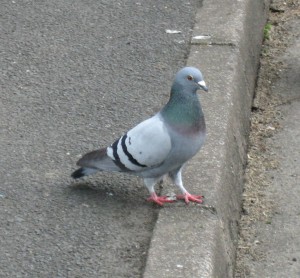Several years ago an intriguing story of successful navigation in complex situation, by pigeons, the birds most often compared to rats, caught my eye.
Our backyard once had a coop full of pigeons, so I’m not a total stranger to their navigation abilities (nor am I a pigeon expert). My favorites were the tumbling pigeons.
But it didn’t take much time researching that article from 2012, to learn that one of the more hotly debated how-do-they-do-it topics is animal navigation, in particular, the ability of pigeons to navigate back to home/point A when released at point B.
So when it appeared online today, in Nature Materials, the story “A Magnetic Protein Biocompass” caught my eye.
Here is the news report by D. Cyranoski.
Examples of animals with magnetorecepting abilities include bats, monarch butterflies, so many migratory birds, and migratory fishes and mammals such as salmon and whales. Often referred to as the sixth sense, the unexplained ability for these creatures to navigate long distances, starting from and returning to the same place, has amazed and fascinated many humans.
Not surprisingly, perhaps, this same navigational sense has long been postulated in some humans.
Here is an example of some of the research into pigeon navigation that sounded promising circa 2012:
Prior to 2012, it was generally agreed that pigeons had iron-rich neurons in their beaks, which read and relayed to their brains, information about their position in magnetic fields. Iron is of course a mineral that responds to magnetic fields and is known to be an important component of human blood cells, involved in carrying oxygen.
In April 2012, David Keays, neuroscientist at the Institute of Molecular Pathology in Vienna, Austria announced that in fact those iron-rich neurons were instead, disease fighting macrophages, immune cells that are found all over the body. (This was the information that I thought would make a perfect blog, until May came around.)
In May 2012, J. David Dickman, neuroscientist at Baylor College of Medicine in Houston, reported that brainstem cells in the inner ear were activated when pigeons are exposed to magnetic fields, noting that these “cells signal direction, intensity and polarity of the earth’s magnetic field”.
Obviously, though Dickman and Keays were close, there was room for more precise information on how these cells, whether in the beak or inner ear, respond to magnetic fields, and now in the November 16 Nature Materials article, biophysicist Can Xie, Peking University in Beijing, says his group has identified the precise protein responsible for the sensitivity to magnetic fields. Their report is: “A Magnetic Protein Biocompass“.
To date, cryptochromes, which are flavoproteins, were the best biochemical candidates for magnetosensing. In addition, it was earlier shown that Cry deficient fruit flies did not show magnetosensing behavior. However, Xie et al. and others know that Cry cannot on it’s own respond to polarity.
Working with Drosophila, Xie et al., first proposed the possibility of a magnetoreceptor protein, then did a genome wide search, in silico for such a protein. They identified Drosophila CG8198, which they named MagR.
In paragraph 3 of a Nature news article on Xie’s research, Peter Hore, a biochemist at the University of Oxford, UK, comments that the research is ‘an extraordinary paper’ but notes that in his publication, Xie, has not shown that the protein complex discovered actually acts like a compass. Hore notes that the paper is ‘either very important or totally wrong’, adding ‘I suspect the latter’.
While I cannot speak to Dr. Hore’s somewhat negative predictions for this work, considering how things have gone in the area of magnetodetection in animals since 2012, it seems that the best approach to us spectating (i.e., waiting on the final word) should be, as with all research, proceed with eyes wide open.
Yet in this skeptic’s opinion, it feels like ground is being covered and even if only on a theoretical level, this report adds to progress that has been made the past several years.
Can’t you just imagine? A Nobel prize awarded to the group that makes the greatest step toward identifying the actual magnetosensing protein complex? Such a prize for research on birds that some call ‘rats with wings’? That would be remarkable.
Here is the Xie paper, online in Nature Materials: http://www.nature.com/nmat/journal/vaop/ncurrent/full/nmat4484.html

